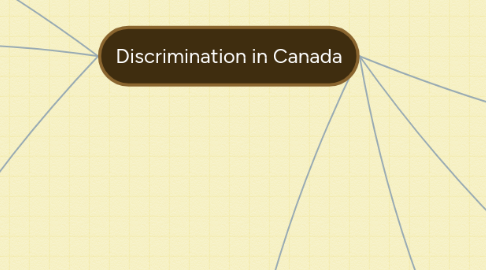
1. Women
1.1. In
1.1.1. World War 1
1.1.1.1. During the war, many women helped the with the war effort, but were not paid as much as men were.
1.1.1.2. Unions fought against hiring women in the work force, as they did not believe that women were right for the job.
1.1.1.3. There were no efforts made by the government to ease women's transition from home to the workplace.
1.1.1.4. Many professions, though, were closed to women, such as medicine, law, and engineering.
1.1.2. The Roaring 20s
1.1.2.1. It was discouraged for women to go to university, so less than 25% of all university students were women.
1.1.2.2. Women who did go to university, went into domestic science or one of the arts.
1.1.2.3. A group of women, known as the Famous Five, appealed to the Supreme Court of Canada to appoint women to the Senate.
1.1.2.3.1. The Supreme Court of Canada ruled that "women were not 'persons' under the Constitution."
1.1.2.3.2. Then, in 1929, these women appealed to the Privy Court of England.
1.1.3. World War 2
1.1.3.1. Many women participated in the war effort as they had done for the first war, and participated in many labor intensive jobs.
1.1.3.2. Women who had husbands or young children were not allowed to enlist. And for those who were allowed, there was many requirements to be accepted.
1.1.4. Post World War 2 to Present
1.1.4.1. Women only represented 22% of the workforce by 1951.
1.1.4.2. Women earned 59% of what men did for doing the exact same job.
1.1.4.3. Women were only allowed to have a credit card if they had their husbands permission.
2. Asians
2.1. In
2.1.1. The Early 20th Century
2.1.1.1. To
2.1.1.1.1. The Chinese
2.1.1.1.2. The Japanese
2.1.1.1.3. Indians
2.1.1.2. All peoples with Chinese, Japanese, and Indian background lost the right to vote in provincial elections in 1920 through the Dominion Elections Act.
2.1.2. World War 2
2.1.2.1. To
2.1.2.1.1. The Japanese
3. Jews
3.1. In
3.1.1. Early 20th Century
3.1.1.1. Jews were seen as a threat to Christian integrity and civilization; they were seen as a symbol of evil.
3.1.2. World War 2
3.1.2.1. The Canadian immigration policy was highly anti-Semitic; Canada was reluctant to accept Jewish refugees.
3.1.2.1.1. One official stated "None is too many."
3.1.2.2. The amount of Jewish refugees that Canada accepted is one of the lowest of the Western countries; only 8 000 were accepted.
4. Blacks
4.1. In
4.1.1. The Early 20th Century
4.1.1.1. People of African origin were not encouraged to immigrate to Canada.
4.1.1.1.1. 'Any immigrant belonging to the Negro race, which race is deemed unsuitable to the climate and requirements of Canada' was prohibited by an Order in Council.
4.1.1.2. African people were not allowed to enlist in the Canadian Army in World War 1 unless their skin was a light shade of brown.
4.1.2. Post World War 2 to Present
4.1.2.1. Black children went to segregated public schools.
4.1.2.2. A racist assault was made against a historic community in Halifax named Africville. The residents were removed and re-housed. The city said that it was for sanitary reasons and to help desegregate.
5. Natives
5.1. In
5.1.1. The Roaring 20s
5.1.1.1. Native children were forced into residential schools by the Canadian government.
5.1.1.1.1. Where the motive of the Canadian government was to make the Aboriginals more like British Canadians through assimilation.
5.1.1.1.2. The children lived in harsh conditions.
5.1.2. Post World War 2 to Present
5.1.2.1. The Indian Act was unjust.
5.1.2.1.1. Aboriginals were prohibited from drinking alcohol.
5.1.2.1.2. Aboriginals needed approval from the Superintendent of Indian Affairs to make land claims or subdivide reserve lands.
5.1.2.1.3. Aboriginals had to give up their status in order to vote in federal elections.
5.1.2.2. Aboriginal women who were married to a non-Aboriginal man would lose their status, as would their children. This, though, would not happen to an Aboriginal man.
6. Ukrainians
6.1. In
6.1.1. World War 1
6.1.1.1. Ukrainians were depicted as enemy aliens by the Canadian government.
6.1.1.2. Around 80 000 Ukrainians were forced to have identity documents on them at all time and to report to Canadian authorities.
6.1.1.3. Over 5 000 were sent to be interned in 24 internment camps across Canada.
6.1.1.4. After the war, many Ukrainians were deported.
6.1.1.5. Some Ukrainian Canadians enlisted for the second World War, to show their loyalty to Canada.
7. Muslims
7.1. In
7.1.1. Present Times
7.1.1.1. In 2015, Prime Minister Stephen Harper proposed to ban the burka, an Islamic head covering.
7.1.1.2. After terrorist attacks made in Paris and Brussels in 2015 made by Daesh, anti-Muslim hate crimes had risen, as many believe Muslims are a threat.
7.1.1.3. Many Canadians are reluctant to accepting Syrian refugees

